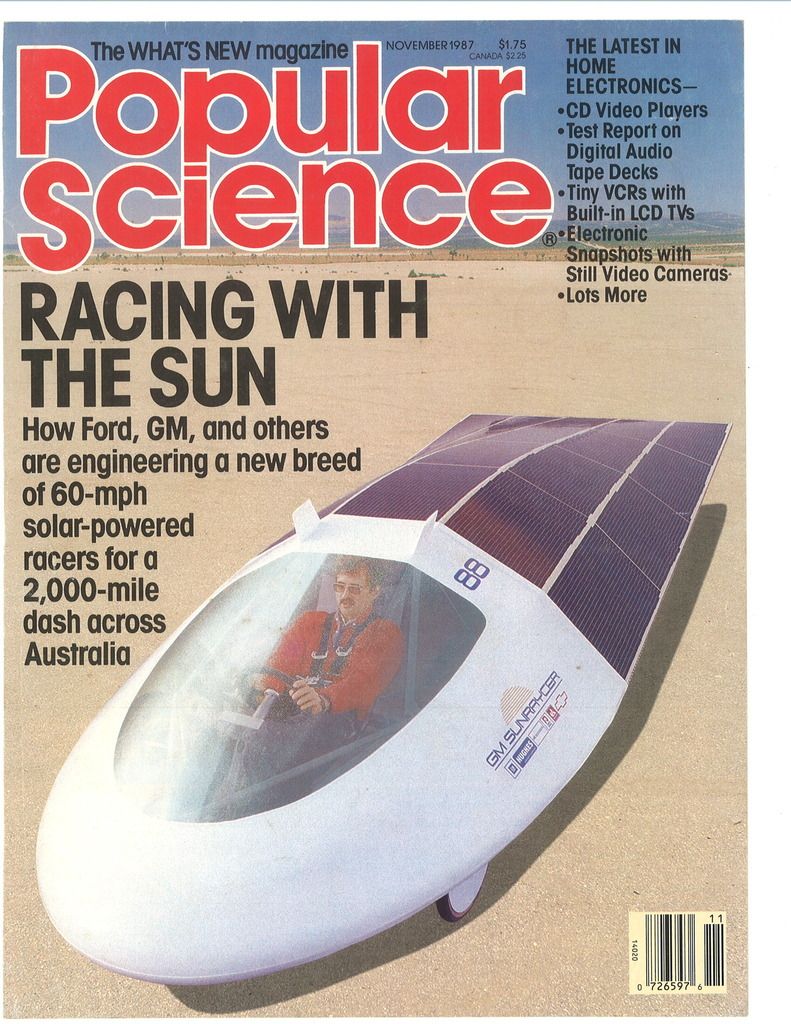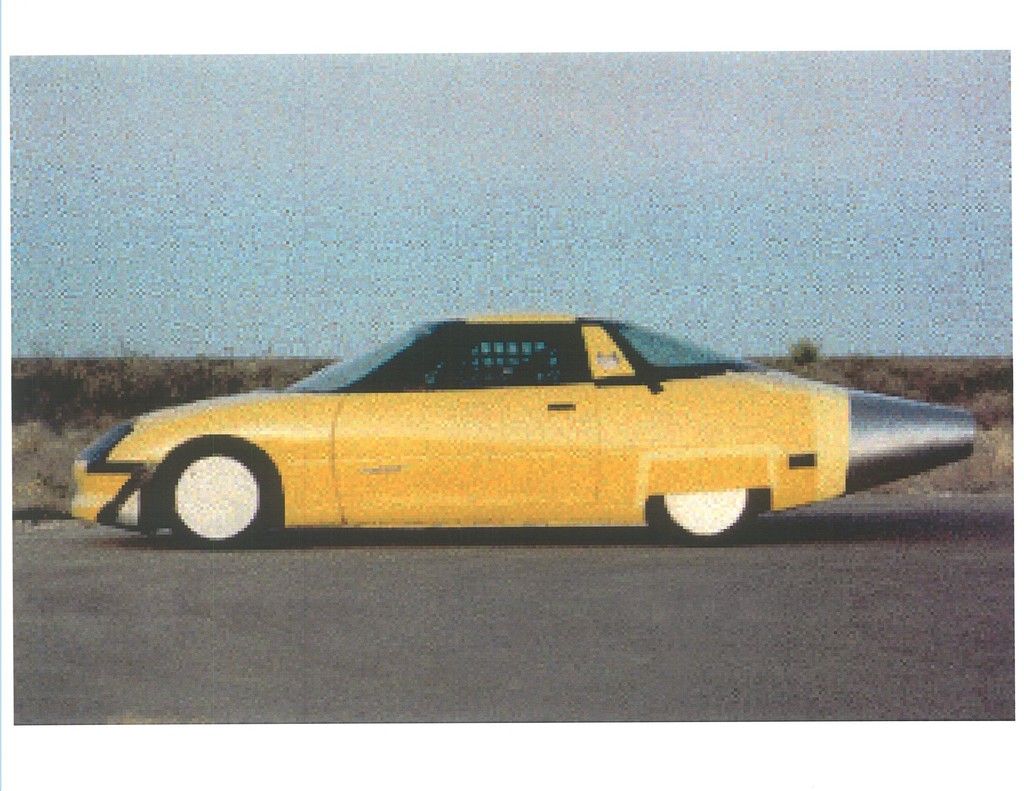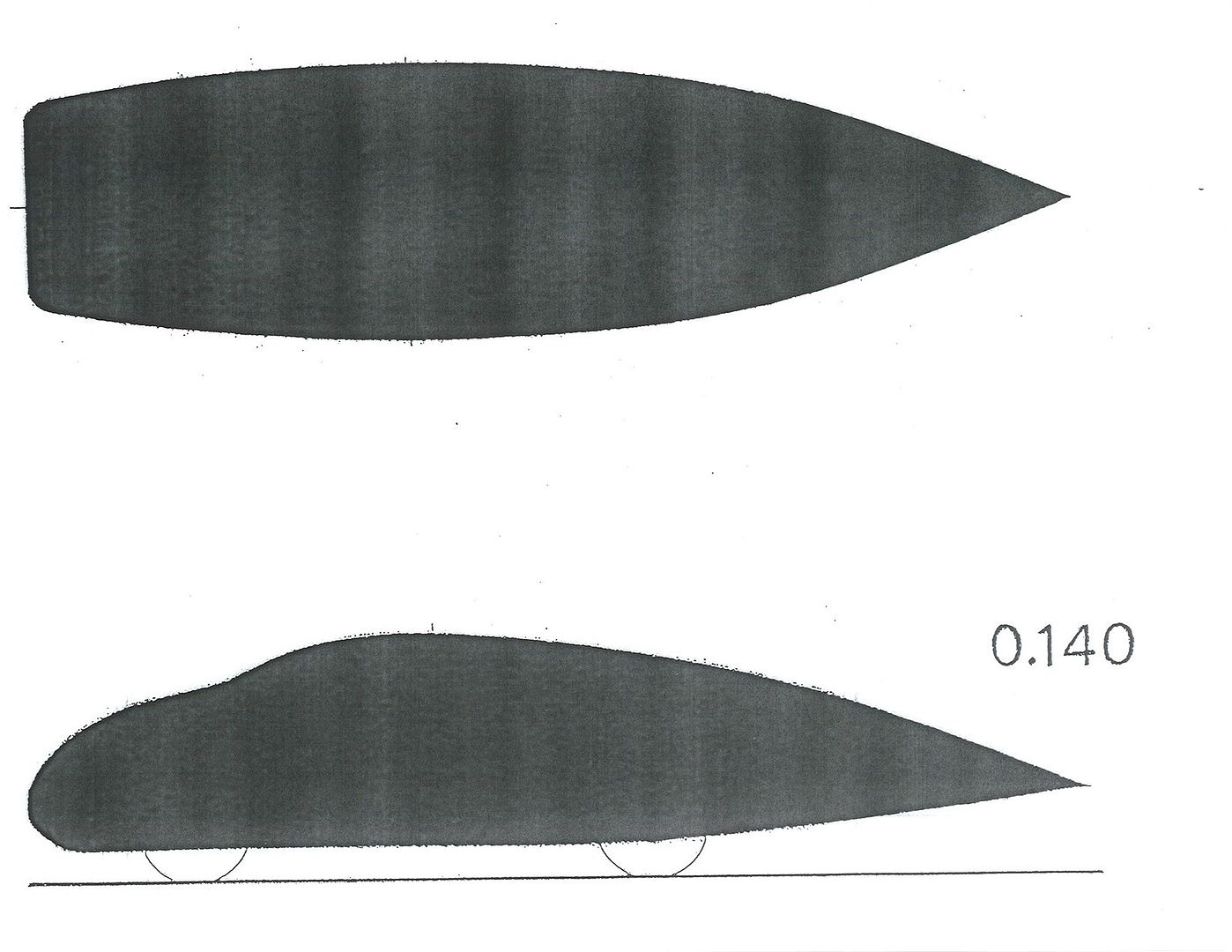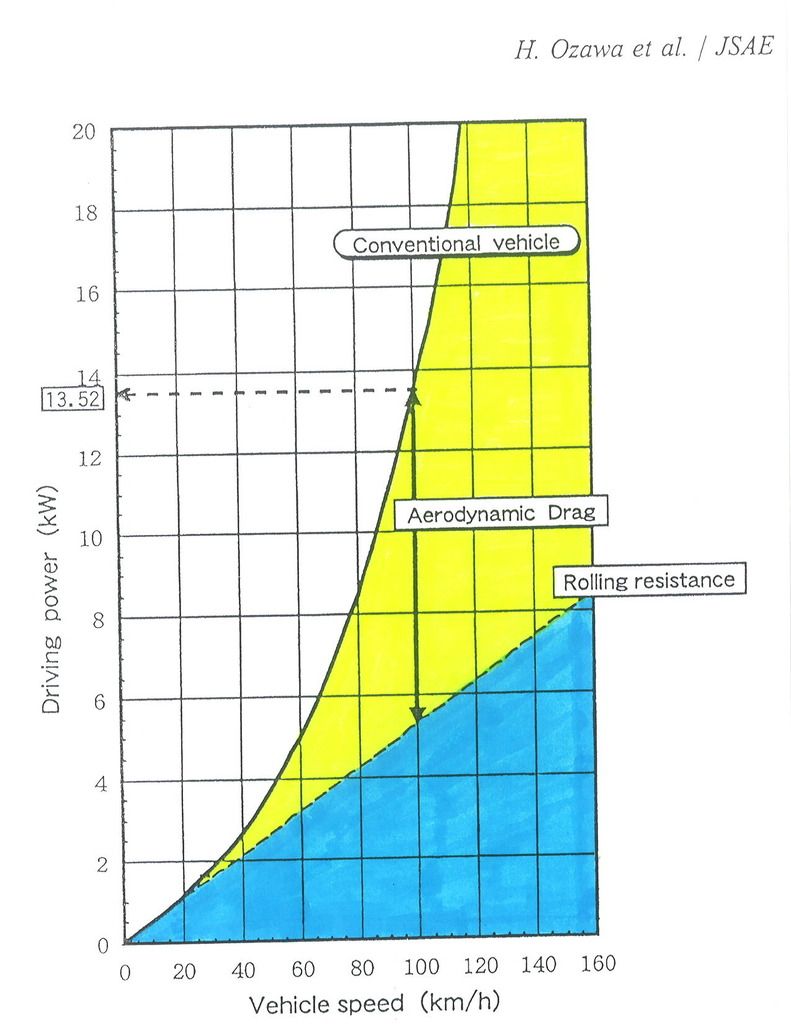 05-09-2016, 04:58 PM
05-09-2016, 04:58 PM
|
#61 (permalink)
|
|
Master EcoModder
Join Date: Jan 2008
Location: Sanger,Texas,U.S.A.
Posts: 15,895
Thanks: 23,972
Thanked 7,223 Times in 4,650 Posts
|
Ev1
Quote:
Originally Posted by NeilBlanchard

Add the EV1 to that list. I think 3D shapes can achieve low drag with steeper angles than the ideal 2D shape?
|
When the GM Impact made its debut in 1987,it's Cd 0.19 was a coup.

It's since been downgraded to Cd 0.21 by GM.
The same year,their Sunraycer was credited with as low as Cd 0.089 (with full wheel fairings).

This shape dates to 1922 when you lose the PV array

This is what Hucho talks about with respect to ultra-low drag aerodynamics.
In 1993,for their land speed record run at Ft.Stockton,GM lowered the Impact and stretched it,in accord with Hucho's recommendation for elongation
The Impact/EV1 LSR is credited with Cd 0.14.

She can go lower with more aft-body refinement.But she 'looks' like an EV1,and that's the point.
GM has been afraid of 'look-a-like' cars since 1923.Low drag cars all look alike when the Cds get low enough.This terrifies automakers bent on design obsolescence.
But back to your point.Cd 0.21 is not the same as Cd 0.08.Certain things have to happen with body architecture to get down there.And there isn't any way to cheat.
__________________
Photobucket album: http://s1271.photobucket.com/albums/jj622/aerohead2/
|
|
|

|
 Today Today
|
|
|
|
 Other popular topics in this forum...
Other popular topics in this forum...
|
|
|
|
 05-09-2016, 05:14 PM
05-09-2016, 05:14 PM
|
#62 (permalink)
|
|
Master EcoModder
Join Date: Jan 2008
Location: Sanger,Texas,U.S.A.
Posts: 15,895
Thanks: 23,972
Thanked 7,223 Times in 4,650 Posts
|
low-drag
Quote:
Originally Posted by Frank Lee

That must be the case. Damn near every low-drag car is steeper than template in the rear.
|
I believe that Cd 0.25 is the 'beginning' of low drag.And since the 1970s,automakers have said that it's a cinch to achieve Cd 0.25 with silhouettes that consumers are familiar with.
So yes,we can build thousands of shapes that will achieve 0.25,Hucho mentioned this in the mid-80s.Sergio Pininfarina around 1980.
Hucho gave us six shapes in a single diagram which returned Cd 0.16-0.15.
These shapes require more careful contours and some wouldn't be fit as actual road cars.
Hucho says Buchheim et al's VW Flow body is the absolute limit as far as 'steepness' of contour.


__________________
Photobucket album: http://s1271.photobucket.com/albums/jj622/aerohead2/
|
|
|

|
 05-09-2016, 05:24 PM
05-09-2016, 05:24 PM
|
#63 (permalink)
|
|
Master EcoModder
Join Date: Jan 2008
Location: Sanger,Texas,U.S.A.
Posts: 15,895
Thanks: 23,972
Thanked 7,223 Times in 4,650 Posts
|
solar aerodynamics
Quote:
Originally Posted by ByDesign

Fun to see the bantering here . . . some of you have a fun sense of humor. Thanks for making me smile.
On aerodynamic shapes, size and speed are really important factors. RC cars were mentioned -- but the speed and size make aerodynamics far less important. (Basically if you have no frontal area, the CD becomes moot.) Similar with Solar vehicles -- at least classically -- they travel at much slower speeds than you'd design for in an automobile. Their big thing is trying to make every last watt count -- and from what I've seen, the biggest advantages are in the mechanics and internal electronics, even the cells -- not the 1/2% difference in aerodynamics. (That's not to trivialize it, just to emphasize there are so many important factors.)
As we compare to production vehicles, there are production and economic and all sorts of other considerations that enter in. Even as trivial as customers that want to see out the back window so they lower the trunk even though it's not ideal aerodynamically. Or, a 7 passenger vehicle -- hard to drop the rear roof line when someone needs to sit back there -- and no sense in making a long tail if a customer can't park in the garage. For one-offs, like us, yea, but not for production.
Generally, you can take any smooth foil shape and use it -- stretch it proportionally -- to meet the need. Longer for higher speed. Any smooth, continuous, convex surface will be better than one with interruptions, discontinuity or concavity. So many times I've seen results of weird stuff just works in the isolated situation and logical stuff fail. If you want to be very exact, there is no substitute for wind tunnel testing.
Per ChazInMT, what are you doing? That will make a big difference with respect to shapes and templates.
|
Here is a road load horsepower curve Honda published for one of the WSC -winning solar racers.You can see that at highway velocity,the majority of power is going to overcome aero drag.And this is a 'car' with Cd 0.10

__________________
Photobucket album: http://s1271.photobucket.com/albums/jj622/aerohead2/
|
|
|

|
|
The Following User Says Thank You to aerohead For This Useful Post:
|
|
 05-14-2016, 07:31 PM
05-14-2016, 07:31 PM
|
#64 (permalink)
|
|
Eco Dabbler
Join Date: Oct 2015
Location: Colorado
Posts: 45
Thanks: 33
Thanked 33 Times in 19 Posts
|
What the graph above does not show is the inefficiencies of converting sunlight into usable energy -- through all the gyrations -- conversion of sunlight, battery efficiency, controller efficiency (they make a lot of heat, which is wasted energy), motor and gearbox efficiency, etc..
True, from a "drag only" perspective, yes, aerodynamics is the big fish, but in terms of total vehicle efficiency --- energy in (or in the case of sunlight, energy available) > vehicle motion --- there are other areas that can yield greater gains.
When we talk about efficiency, changing CD by a few points is great. However, if we could change efficiency of the solar cells from sub 20% (at the time of the Honda sun races) to double that, well, twice as much energy for free, that's efficiency gains. To some extent, internal inefficiencies like charging / discharging batteries and the heat created by electronics (hence the need for other inefficiencies like fans), well, those are big, and they are not shown in "drag" graphs.
The point here is all these aspects are important. Aerodynamics is one very important piece of the puzzle, but there are other pieces that are often overlooked because they are not as "visible". Looking only at the outside limits our perspective. Looking only at the inside limits it as well. Thinking 2D limits us just as much. It's a system, so to really address efficiency, we have to address the whole.
|
|
|

|
|
The Following User Says Thank You to ByDesign For This Useful Post:
|
|
 05-14-2016, 09:28 PM
05-14-2016, 09:28 PM
|
#65 (permalink)
|
|
Master EcoModder
Join Date: Aug 2012
Location: northwest of normal
Posts: 27,698
Thanks: 7,776
Thanked 8,585 Times in 7,069 Posts
|
What the graph above does not show is things that don't vary with speed... like conversion of sunlight.
When we talk about efficiency, changing efficiency of the solar cells by a few points is great. However, if we could change CD to half that, well, twice as much energy for free, that's efficiency gains.
|
|
|

|
 05-18-2016, 01:53 PM
05-18-2016, 01:53 PM
|
#66 (permalink)
|
|
Master EcoModder
Join Date: Jan 2008
Location: Sanger,Texas,U.S.A.
Posts: 15,895
Thanks: 23,972
Thanked 7,223 Times in 4,650 Posts
|
graph
The graph only illustrates 'Road Load Horsepower',where the available power delivered to the traction wheel(s) is absorbed.
It has nothing to do with thermal efficiency of the prime mover,accessory losses,or power train mechanical efficiency.
What is does show,is that,at highway velocity, aerodynamic drag constitutes the greatest portion of an automobiles power requirement,and is the greatest source for energy efficiency improvement.
__________________
Photobucket album: http://s1271.photobucket.com/albums/jj622/aerohead2/
|
|
|

|
 05-21-2016, 03:21 PM
05-21-2016, 03:21 PM
|
#67 (permalink)
|
|
Master EcoModder
Join Date: Jan 2008
Location: Sanger,Texas,U.S.A.
Posts: 15,895
Thanks: 23,972
Thanked 7,223 Times in 4,650 Posts
|
'conventional' car road load horsepower graph
I parsed out the 'conventional' car road load hp curve from the 1996 Honda Dream solar racer graph.

The representative car might be a 1996 Accord Sedan,since this is the bread and butter for car sales.
You can see how exponential/geometric the aerodynamic drag curve is,while the Rolling-Resistance load is linear (up to the tires standing wave velocity).
This yellow area drives home the importance of drag coefficient,if we take the easy way,leaving the frontal area alone.
__________________
Photobucket album: http://s1271.photobucket.com/albums/jj622/aerohead2/
|
|
|

|
 06-11-2021, 03:08 PM
06-11-2021, 03:08 PM
|
#68 (permalink)
|
|
Master EcoModder
Join Date: Jan 2008
Location: Sanger,Texas,U.S.A.
Posts: 15,895
Thanks: 23,972
Thanked 7,223 Times in 4,650 Posts
|
graph
Quote:
Originally Posted by ByDesign

What the graph above does not show is the inefficiencies of converting sunlight into usable energy -- through all the gyrations -- conversion of sunlight, battery efficiency, controller efficiency (they make a lot of heat, which is wasted energy), motor and gearbox efficiency, etc..
True, from a "drag only" perspective, yes, aerodynamics is the big fish, but in terms of total vehicle efficiency --- energy in (or in the case of sunlight, energy available) > vehicle motion --- there are other areas that can yield greater gains.
When we talk about efficiency, changing CD by a few points is great. However, if we could change efficiency of the solar cells from sub 20% (at the time of the Honda sun races) to double that, well, twice as much energy for free, that's efficiency gains. To some extent, internal inefficiencies like charging / discharging batteries and the heat created by electronics (hence the need for other inefficiencies like fans), well, those are big, and they are not shown in "drag" graphs.
The point here is all these aspects are important. Aerodynamics is one very important piece of the puzzle, but there are other pieces that are often overlooked because they are not as "visible". Looking only at the outside limits our perspective. Looking only at the inside limits it as well. Thinking 2D limits us just as much. It's a system, so to really address efficiency, we have to address the whole.
|
The graph shows a car that would get 400 miles per gallon on the highway, with a modest ICE powertrain, according to it's creators.
__________________
Photobucket album: http://s1271.photobucket.com/albums/jj622/aerohead2/
|
|
|

|
 06-11-2021, 03:44 PM
06-11-2021, 03:44 PM
|
#69 (permalink)
|
|
Master EcoModder
Join Date: Aug 2012
Location: northwest of normal
Posts: 27,698
Thanks: 7,776
Thanked 8,585 Times in 7,069 Posts
|
ByDesign Last Activity: 03-06-2018 01:41 PM
__________________
.
.Without freedom of speech we wouldn't know who all the idiots are. -- anonymous poster
____________________
.
."We're deeply sorry." -- Pfizer
|
|
|

|
|
The Following User Says Thank You to freebeard For This Useful Post:
|
|
|